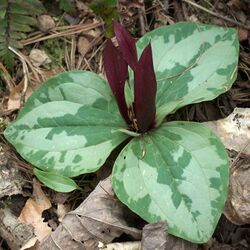Biology:Trillium decumbens
| Trillium decumbens | |
|---|---|

| |
| Scientific classification | |
| Kingdom: | Plantae |
| Clade: | Tracheophytes |
| Clade: | Angiosperms |
| Clade: | Monocots |
| Order: | Liliales |
| Family: | Melanthiaceae |
| Genus: | Trillium |
| Species: | T. decumbens
|
| Binomial name | |
| Trillium decumbens Harb.[2]
| |
Trillium decumbens, also known as the decumbent trillium[3] or trailing wakerobin,[4] is a species of flowering plant in the bunchflower family (Melanthiaceae). It is native to the southeastern United States , specifically Tennessee , Georgia, and Alabama,[5] where it grows in mature deciduous woodlands or on open rocky wooded slopes.[6]
Description
Trillium decumbens is a perennial herbaceous plant that blooms from mid-March to April. The dark maroon flower petals are long and twisted, and held upright at full bloom. The flowers emit a strongly fetid odor.[3] Unlike most other trilliums, its stems grow along the ground ("decumbent") rather than standing upright, so that the plant appears to rest on the surrounding leaf litter. This characteristic is what drew the attention of its discoverer, Charles Lawrence Boynton.[7] Its leaves are mottled green and silver. They die back early in the season while the fruit, a dark purple berry, is still developing. By early autumn, the ripe fruit is presented on a stalk without surrounding leaves.[3]
Taxonomy
Trillium decumbens was first described by American botanist Thomas Grant Harbison in 1902.[2] It was one of several Trillium species described by Harbison as part of a project to review what he considered the neglected biodiversity within the genus. He emphasized the uniqueness of its combination of a decumbent and finely-hairy stem, relatively large and twisted petals, and prominently elongated anther connectives to distinguish it from other trilliums.[7]
Several "amazingly disjunct"[8] central Georgia populations formerly identified as T. decumbens are thought to constitute a new species, Trillium delicatum Floden & E.E.Schill..[9] The latter differs markedly from T. decumbens genetically, morphologically, and ecologically, resembling it only in general appearance.[10]
Conservation
The global conservation status of Trillium decumbens is apparently secure (G4).[1] It is critically imperiled in the Tennessee and vulnerable in both Georgia and Alabama.
References
- ↑ 1.0 1.1 "Trillium decumbens". NatureServe Explorer. NatureServe. https://explorer.natureserve.org/Taxon/ELEMENT_GLOBAL.2.143981/Trillium_decumbens.
- ↑ 2.0 2.1 "Trillium decumbens Harb.". International Plant Names Index (IPNI). Royal Botanic Gardens, Kew. https://www.ipni.org/n/258307-2.
- ↑ 3.0 3.1 3.2 Case Jr., Frederick W. (2002), "Trillium decumbens", in Flora of North America Editorial Committee, Flora of North America North of Mexico (FNA), 26, New York and Oxford, http://www.efloras.org/florataxon.aspx?flora_id=1&taxon_id=242101989
- ↑ "Trillium decumbens". Natural Resources Conservation Service PLANTS Database. USDA. https://plants.usda.gov/core/profile?symbol=TRDE3. Retrieved 15 December 2015.
- ↑ "Trillium decumbens", County-level distribution map from the North American Plant Atlas (NAPA) (Biota of North America Program (BONAP)), 2014, http://bonap.net/MapGallery/County/Trillium%20decumbens.png, retrieved 7 October 2019
- ↑ Pistrang, Mark. "Decumbent Trillium (Trillium decumbens)". United States Forest Service. https://www.fs.fed.us/wildflowers/plant-of-the-week/trillium_decumbens.shtml.
- ↑ 7.0 7.1 Harbison, T. G. (1902). "New or little known species of Trillium, II". Biltmore Botanical Studies 1 (2): 158. https://www.biodiversitylibrary.org/page/42992604#page/190/mode/1up. Retrieved 7 October 2019.
- ↑ Patrick, Tom (2007). "Trilliums of Georgia". Tipularia 22: 3–22.
- ↑ "Trillium delicatum Floden & E.E.Schill.". Royal Botanic Gardens, Kew. https://powo.science.kew.org/taxon/urn:lsid:ipni.org:names:77197178-1.
- ↑ Schilling, Edward E.; Floden, Aaron; Lampley, Jayne; Patrick, Thomas S.; Farmer, Susan B. (2019). "A New Species of Trillium (Melanthiaceae) from Central Georgia and its Phylogenetic Position in subgenus Sessilium". Systematic Botany 44 (1): 107–114. doi:10.1600/036364419X697958.
Bibliography
- Frett, Jeanne (2007). Trilliums at Mt. Cuba Center: A Visitor's Guide. Mt. Cuba Center Inc. ISBN 978-0-9770848-1-4.
- Armitage, Allan M. (2011). Armitage's Garden Perennials. Timber Press. pp. 315–317. ISBN 978-1-60469-038-5.
External links
- Citizen science observations for Trillium decumbens at iNaturalist
- Biodiversity Information Serving Our Nation (BISON) occurrence data and maps for Trillium decumbens
Wikidata ☰ Q3024432 entry
 |


